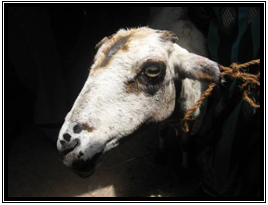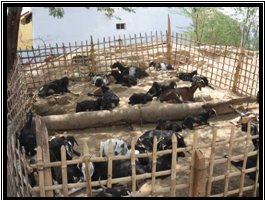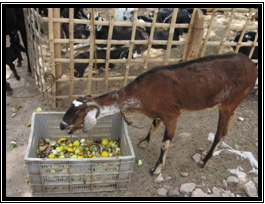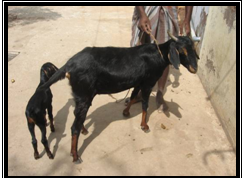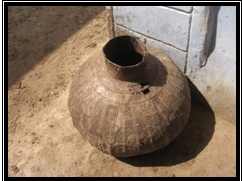ITK followed in Thoothukudi District
Crude Ethno Veterinary Practice
In Kothali village of Ottapidaram Block of Thoothukudi District, they are following crude method of Ethno Veterinary Practice. In which they cut the proximal extremity of both the ears and make a second degree burn injury on the frontal area of skull by using red hot iron. This practice followed for the purpose of treatment for epilepsy and magnesium tetany diseases of livestock.
Indigenous feed box for small ruminants
Iron trunk boxes which are previously used for keeping clothes and valuables now a day used as the feed box for small ruminants. Goats and Sheep will not eat the grasses which are mixed with the soil, dung and urine. So this iron plate box is very much useful for the safe feeding of small ruminants. This practice has been followed in Kothali village of Ottapidaram Block.
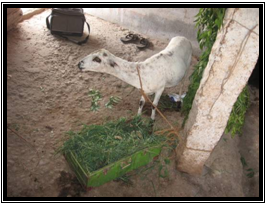 |
Innovative Indigenous Dry land Cycle Weeder
In Kothali village of Thoothukudi District a farmer namely Shri. Arumugam has indigenously developed dry land weeder by modified bicycle wheel. It is easy to operate with the help of long handle and the bottom side is fixed with iron plate which is used to remove the dry land weeds. This weeder is much useful in crops which are planted in ridges and furrows. It costs about Rs. 750 /-. The operation of the implement is just by walking and application of gentle pressure by hands. Both men and women can very easily operate this implement in line sowing crops. This implement is the farmer’s own innovation and is being used for the past 10 years.
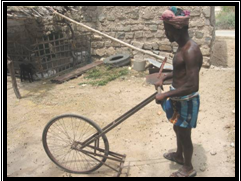 |
a. Function
For weeding in row crops and for removing shallow rooted weeds. It has been designed ergonomically for easy operation. Useful in dryland and gardenland crops is ideal at a soil moisture content of 8 to10 per cent.
b. Specification
Type : Manually operated
Power requirement : A man labourer
.Weight : 3 kg.
Capacity : 0.05 ha/day
c. Cost of the unit :Rs. 350/-
d. Cost of operation :Rs. 800/ha.
| Name of the practice |
District |
ITK Holder |
| Crude Ethno Veterinary Practices, Indigenous feed box for small ruminants, Innovative and Indigenous Dry land Cycle Weeder |
Thoothukudi |
Th.Subaramani.,
Kothali |
Paddock
It is the closed structure by using bamboo sticks. It is used to keep the small ruminants in closed confinement without roof. Some Sheep and Goat farmers are in the form of nomadic life. During their nomadic life after grazing the animals this paddock will very much useful to confine their animal in a closed proximity.
Traditional cholam (kakacholam)
Traditional cholam varieties are grown in Kothali village of Thoothukudi district. It is a black seed variety. Duration of the crop is 6 months. They are cultivating this crop as rain fed and irrigated crop. The Seed rate is 30 kg /acre. It may be sown in the month of September- October and to be harvested in the month of January - February. The seeds are kept for next sowing by farmers themselves. This variety is suitable for livestock as fodder. It can be used as inter crop with any other crop.
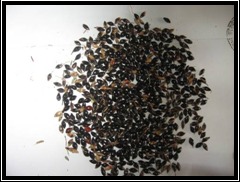 |
Tirunelveli, Thoothukudi
1. Thaipattam K 8, CO 25, CO 21, K 4, COH 3,CO 26, COH 4, BSR 1,
2. Chithiraipattam K 8, CO 25, K 4, CSH 5, COH 3,CO 26, COH 4, BSR 1,
K 9 for Tenkasi tract
3. Adipattam K 8, CO 21, K4, K Tall, COH 3,CO 25, CO 26, BSR 1, APK 1
4. Puratasipattam CO 25, KTall, CO 26, K 8, K 10, BSR 1, APK 1
Note: Thaipattam: January - February; Chithiraipattam: April - May; Adipattam: June - July;
Puratasipattam: September - October
SELECTION OF SEEDS
Good quality seeds are collected from disease and pest-free fields.
Quantity of seed required
Irrigated Transplanted - 7.5 kg/ha, Direct sown -10 kg/ha, Rainfed Direct sown- 15 kg/ha
Sorghum under irrigated condition is raised both as a direct sown and as a transplanted crop. Treat the seeds 24 hours prior to sowing with Carbendazim or Captan or Thiram 2g/kg of seed. Harden the seeds with 1% aquous fresh leaf extract of Prosopis juliflora and pungam,(Pongamia pinnata) mixed in 1:1 for 16 hrs at 1:0.6 ratio (Seed and solution) followed by drying and subsequently pelleting the seeds with Pungam leaf powder @300 g/ka with gruel.
5. THINNING OF THE SEEDLINGS AND GAP FILLING
Direct sown crop
Thin the seedlings and gap fill with the seedlings thinned out. Maintain a spacing of 15 cm between plants after the first hand weeding on the 23rd day of sowing. Thin the pulse crop to a spacing of 10 cm between plants for all pulse crop except cowpea, for which spacing is maintained.
Preparation of Arpocarb fishmeal formulation for shootfly attraction:
Fishmeal powder is to be sprayed first with 2.0 per cent starch dissolved in hot water as a sticking agent. The insecticide Arpocarb should then be sprayed at 50 ml/kg of fishmeal powder. The resultant mixture is shade dried and can be used at 50 g/trap. The formulated product should be moistened well before placing in the trap. The formulation can be changed once in 10 - 14 days depending upon the smell. The sowing of sorghum should be completed in as short a time as possible to avoid continuous flowering which favours grain midge and earhead bug multiplication in an area.
HARVESTING AND PROCESSING
i. Consider the average duration of the crop and observe the crop. When the crop matures
the leaves turn yellow and present a dried up appearance.
ii. The grains are hard and firm.
iii. At this stage, harvest the crop by cutting the earheads separately.
iv. Cut the straw after a week, allow it to dry and then stack.
v. In the case of tall varieties, cut the stem at 10 to 15 cm above ground level and afterwards
separate the earheads and stack the straw.
vi. Dry the earheads.
vii. Thresh using a mechanical thresher or by drawing a stone roller over the earheads or by
using cattle and dry the produce and store.
| Name of the practice |
District |
ITK Holder |
| Paddock and Traditional cholam (kakacholam) |
Thoothukudi |
Th. Arumugam
kothali |
Goat feeding
Kids below the age of 3 months will not be allowed for grazing. Normally they kept in goat shed in day times. At that time they feed with neem leaves as shown in the photographs. The neem leaves are tied together and again tied in the beam just 2 feet from the floor level. This elevated arrangement will certainly help the kids to eat properly.
Cheng Kanni Adu
Cheng Kanni Adu is the variety of Kanni Adu. It is the native of Kovilpatti, Sattur and Sankarankoil taluks of Thoothukudi, Virudhunagar and Tirunelveli Districts respectively. In total Kanni Adu population 75 % are Pal Kanni Adu and the remaining 25% only Cheng Kanni Adu. This variety is the tastiest meat producer in Tamilnadu. Normally this breed delivers twins. 18% of Cheng Kanni Does will deliver triplets. The average adult body weight is 36 kgs in male and 29 kgs in female animals. This breed is highly suitable for rain fed region.
9. Mixed cropping Chillies + Castor + Agathi
Chillies, castor and agathi are raised in same piece of land as mixed crop. In this, chillies are the main crop. Castor is the border crop, which is raised along the side of the bunds. In between chillies and castor, agathi is raised. Agathi is leguminous tree fodder which is a protein supplement to small ruminants and also used as green leaf manure .Agathi growth is limited up to 10 feet height for easy management. The castor crop is used for castor oil extraction and the castor leaves are used as green fodder to live stock.
Chilliy (Capsicum annum)
Varieties
K1, K2, Co1, Co2 (vegetable type) PKM 1 PKM 2 (For semidry conditions in Southern district
Season: January-February, June –July, and September-October
Seed rate: 500 gm per acre
Planting method: Rides &furrows
Fertilizer applications: Applications of Potassium in the form of potassium sulphate will increase quality of chilies
Use of growth regulator:Tricontinol@1.25 ml/liter
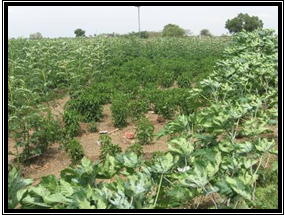 |
| Name of the practice |
District |
ITK Holder |
| Goat feeding, Cheng Kanni Adu, Mixed cropping Chillies + Castor + Agathi |
Thoothukudi |
Th . Anthony
Vadaku mayilodai |
10.“KOONAI” (Traditional Water Carrier)
It is used to carry water from well. It is made up of iron plates and the mouth is tied with leather tube for uniform flow of water. By using long ropes and with the help of Bullocks it carries around 60 litres of water at a time. Because of the invention of diesel and electric motor pump sets this KOONAI is just the thing in museum. Now a day in rural areas the so called KOONAI is used for Poultry shed or kozhi koodu.
| Name of the practice |
District |
ITK Holder |
| “KOONAI” (Traditional Water Carrier) |
Thoothukudi |
Th. Shamugam
Therku Maylodi |
|

